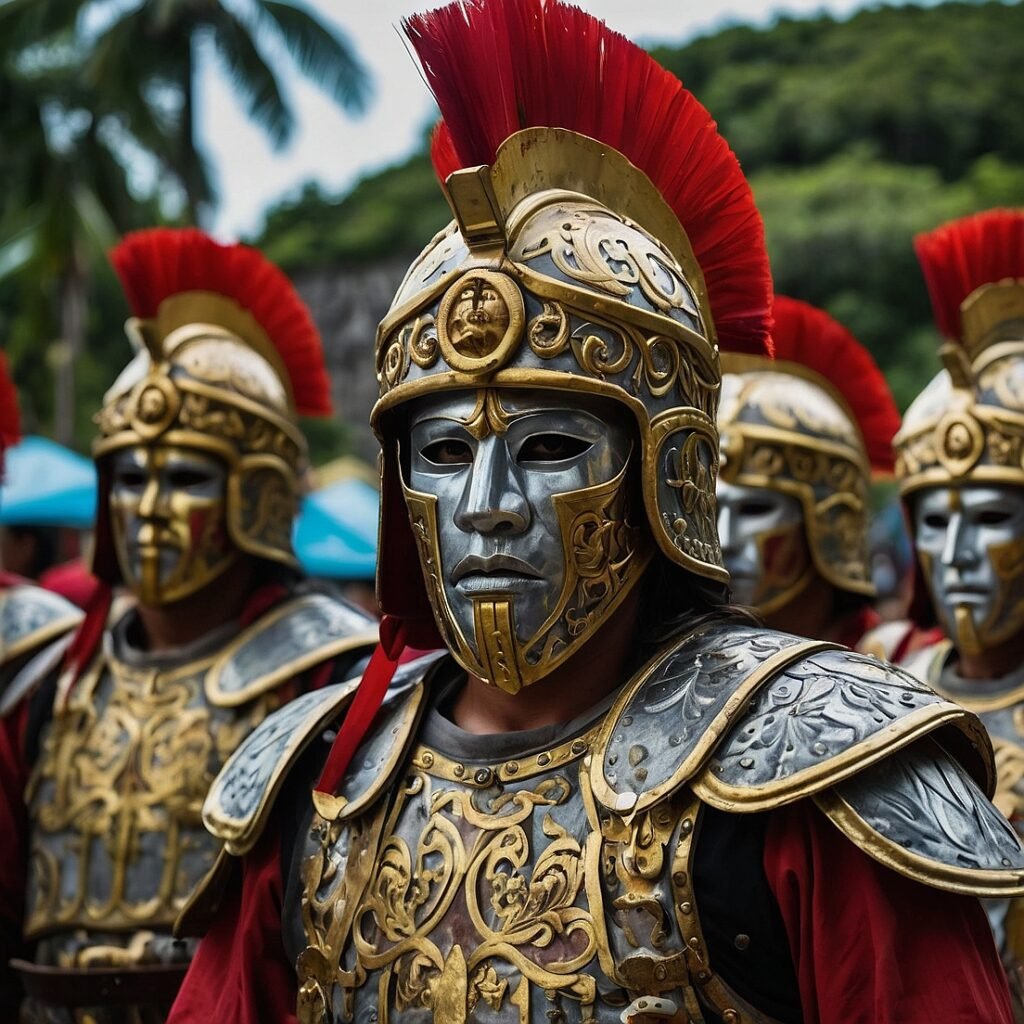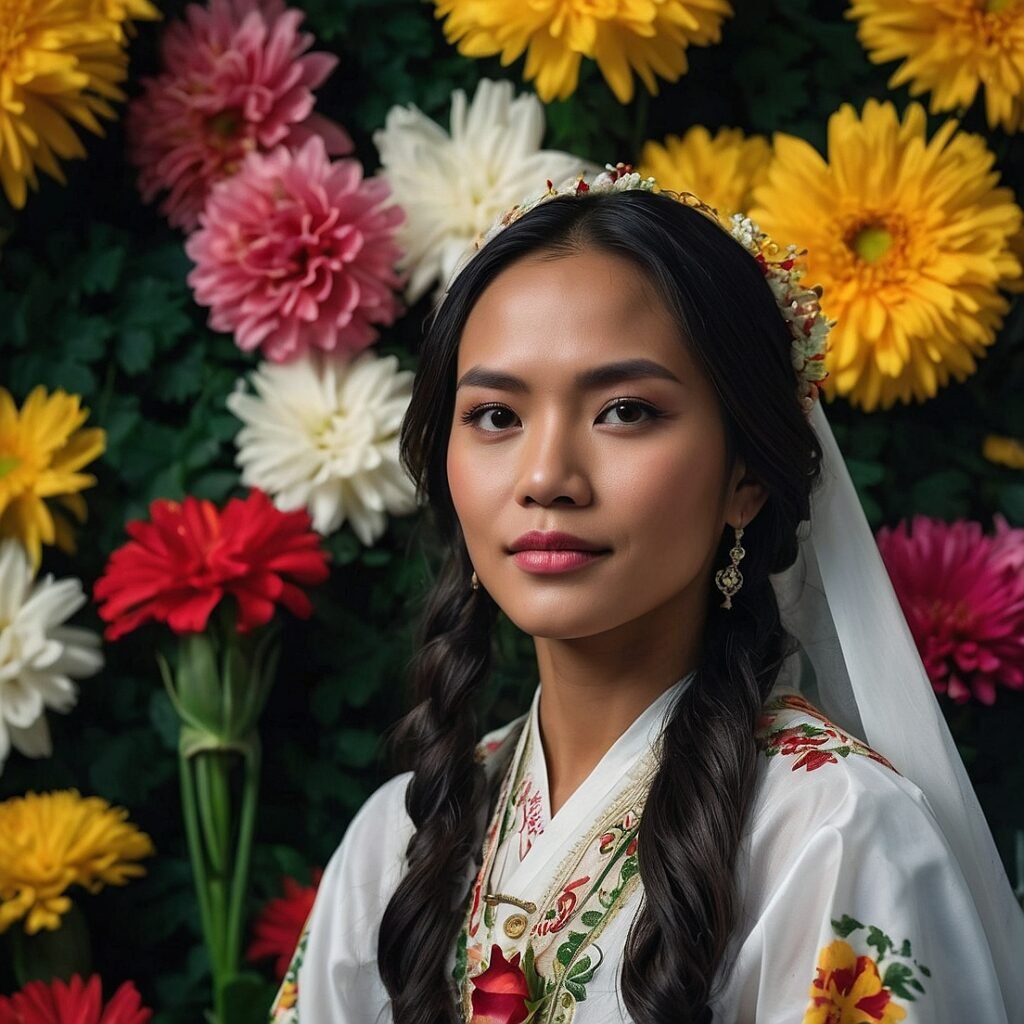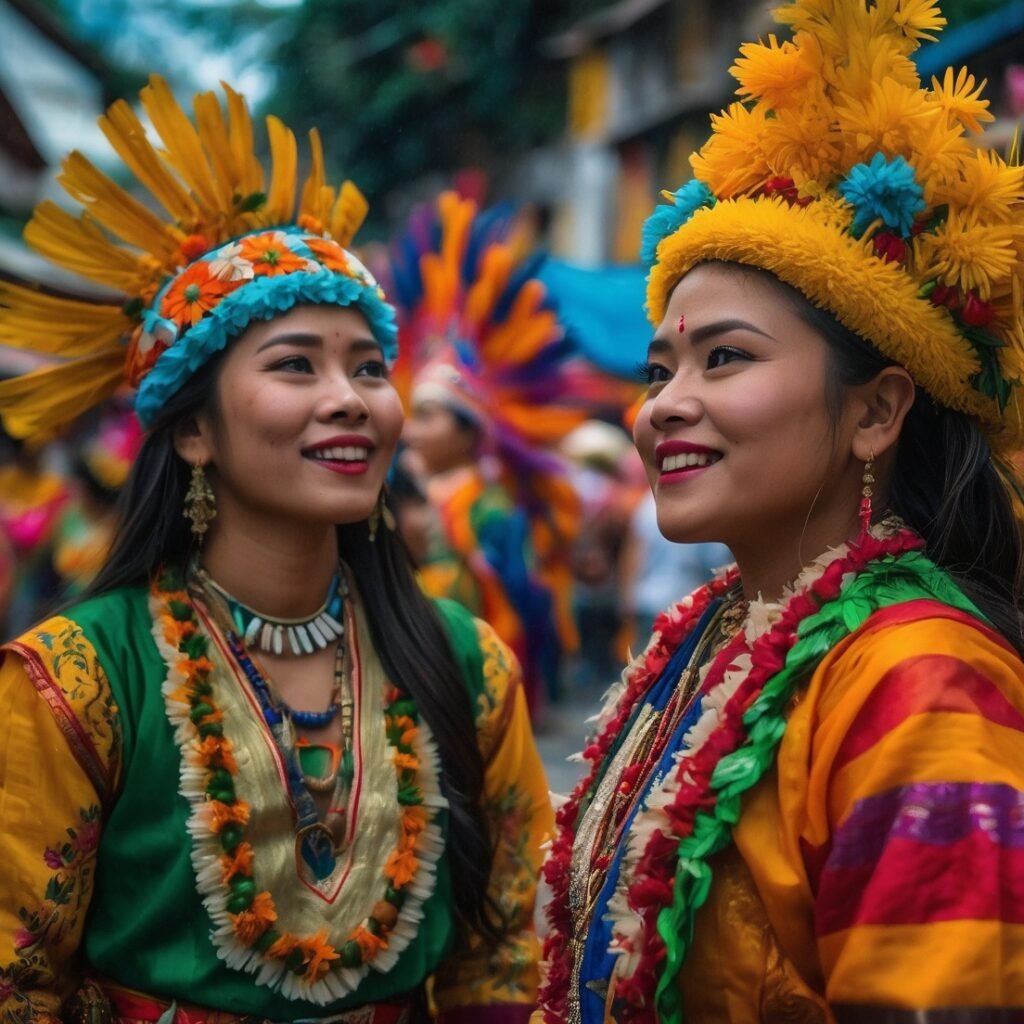Have you ever wondered what it would be like to step back in time and witness Roman soldiers roaming the streets during Holy Week? Well, in the heart of the Philippines, on the island province of Marinduque, you can do just that! Welcome to the world of the Moriones Festival, a vibrant and unique celebration that brings together faith, culture, and history in a truly spectacular way.
Picture this: streets filled with men donning intricate masks and colorful costumes, reenacting scenes from ancient Rome, all while commemorating the passion and death of Jesus Christ. It’s a feast for the senses and a testament to the rich cultural tapestry of the Philippines. In this blog post, we’ll dive deep into the fascinating world of the Moriones Festival, exploring its origins, traditions, and the impact it has on both locals and visitors alike.
So, grab a cup of coffee, sit back, and let’s embark on a journey to discover one of the most intriguing Lenten celebrations in the world. Trust me, by the end of this post, you’ll be itching to book your tickets to Marinduque and experience this incredible festival for yourself!
The Origins: A Tale of Faith and Tradition
The Legend of Longinus
At the heart of the Moriones Festival lies a captivating legend that has been passed down through generations. It’s the story of Longinus, a Roman centurion who, according to Christian tradition, pierced the side of Jesus Christ during his crucifixion. As the legend goes, Longinus was blind in one eye, but when some of Jesus’ blood splashed onto his face, his sight was miraculously restored. This incredible event led to Longinus’ conversion to Christianity and, ultimately, to his martyrdom.
The Moriones Festival brings this legend to life, with local men dressing up as Roman soldiers, or “Moriones,” to reenact Longinus’ story. It’s a powerful way for the people of Marinduque to connect with their faith and share an important part of Christian history with visitors from around the world.
A Century-Old Tradition
While the legend of Longinus dates back to biblical times, the Moriones Festival itself has a more recent origin. The celebration as we know it today began in the early 1800s, thanks to the creative vision of a local parish priest named Padre Dionisio Santiago. Inspired by the penitential practices of the locals during Holy Week, Padre Santiago decided to incorporate the story of Longinus into the celebrations, giving birth to the colorful and dramatic festival we see today.
Over the years, the Moriones Festival has evolved, incorporating elements of Filipino culture and becoming a beloved tradition not just in Marinduque, but recognized throughout the Philippines and beyond. It’s a beautiful example of how faith, culture, and creativity can come together to create something truly unique and enduring.
The Moriones: Masked Men with a Mission
Becoming a Morion: More Than Just a Costume
Now, let’s talk about the stars of the show – the Moriones themselves. These aren’t just people in fancy dress; becoming a Morion is a serious commitment and a source of great pride for the men of Marinduque. The process of transforming into a Morion begins weeks, sometimes even months, before Holy Week.
Participants spend countless hours crafting their elaborate masks, known as “morion,” which are typically made from wood, paper mache, or fiberglass. These masks are true works of art, often featuring exaggerated Roman facial features, fierce expressions, and brightly painted designs. The attention to detail is astounding, with each mask being a unique creation that reflects the personality and skill of its maker.
But it’s not just about the mask. The full Morion costume includes a colorful tunic, cape, boots, and, of course, the iconic Roman soldier’s helmet. Many Moriones also carry wooden swords and spears, adding to the authentic feel of their portrayal. The overall effect is both intimidating and awe-inspiring, creating a visual spectacle that’s hard to forget.
A Labor of Love and Faith
For many participants, being a Morion is more than just a festival role – it’s a form of religious devotion and penance. Some men make vows to participate in the festival for a certain number of years as an act of thanksgiving or to ask for divine intervention in their lives. This deep spiritual connection adds a layer of solemnity and reverence to the otherwise festive atmosphere.
The dedication of these men is truly remarkable. During the festival, they remain in character from Holy Monday to Easter Sunday, parading through the streets, participating in religious processions, and interacting with the crowds. It’s a physically demanding role, especially under the hot Philippine sun, but the Moriones carry out their duties with unwavering commitment and enthusiasm.
The Festival Experience: A Week of Wonder
Holy Week Highlights
The Moriones Festival isn’t just a one-day event – it’s a week-long celebration that transforms the entire island of Marinduque. While the festivities officially kick off on Holy Monday, the excitement starts building long before that. Here’s a quick rundown of what you can expect throughout the week:
- Holy Monday to Holy Wednesday: The Moriones begin their parades, roaming the streets and playfully chasing children and tourists. It’s a great time to admire their costumes up close and maybe even snag a selfie or two!
- Maundy Thursday: This day sees the reenactment of the Last Supper and the Washing of the Feet ceremony in local churches.
- Good Friday: One of the most solemn days of the festival, featuring the reenactment of the Crucifixion and the Via Crucis (Way of the Cross) procession.
- Black Saturday: The search for Longinus begins! This day is filled with dramatic street performances as the Moriones hunt for the converted centurion.
- Easter Sunday: The festival reaches its climax with the capture and beheading of Longinus, followed by joyous Easter celebrations.
Throughout the week, you’ll also find various cultural shows, street performances, and religious services happening across the island. It’s a non-stop whirlwind of activity that keeps both locals and visitors thoroughly engaged.
Beyond the Masks: Other Festival Highlights
While the Moriones are undoubtedly the main attraction, there’s so much more to experience during the festival. Here are some other highlights you won’t want to miss:
- Pugutan: This is the dramatic reenactment of Longinus’ beheading, usually performed on Easter Sunday. It’s a powerful and emotional scene that serves as the festival’s grand finale.
- Senakulo: Throughout the week, you can catch performances of the Senakulo, a traditional Filipino play that depicts the passion and death of Jesus Christ.
- Local Delicacies: No festival is complete without food! Be sure to try some Marinduque specialties like arrowroot cookies, uraro, and the famous kare-kare (a peanut-based stew).
- Arts and Crafts: Many local artisans set up stalls selling handmade Morion masks, souvenirs, and other traditional crafts.
- Beach Time: Marinduque is blessed with beautiful beaches, so why not take some time to relax by the sea in between festival activities?
The Impact: More Than Just a Festival
Preserving Culture and Boosting Tourism
The Moriones Festival isn’t just a colorful spectacle – it plays a crucial role in preserving Filipino culture and boosting the local economy. Let’s take a look at some of the ways this festival makes a lasting impact:
- Cultural Preservation: By keeping this centuries-old tradition alive, the people of Marinduque are ensuring that important aspects of Filipino history and culture are passed down to future generations. The festival serves as a living museum, allowing people to experience and learn about traditional customs, craftsmanship, and religious practices.
- Tourism Boost: As one of the most unique festivals in the Philippines, the Moriones celebration attracts thousands of domestic and international tourists each year. This influx of visitors provides a significant boost to the local economy, benefiting hotels, restaurants, transportation services, and small businesses across the island.
- Artisan Support: The festival creates a demand for traditional crafts, particularly the intricate Morion masks. This helps support local artisans and keeps traditional art forms alive and thriving.
- Community Building: Preparing for and participating in the festival brings the community together, fostering a sense of pride and unity among the people of Marinduque. It’s a time when everyone, from children to elders, can contribute and feel part of something bigger than themselves.
Challenges and Adaptations
Like many cultural events worldwide, the Moriones Festival has faced its share of challenges in recent years. The COVID-19 pandemic, in particular, forced organizers to rethink how the festival could continue while keeping everyone safe. In 2020 and 2021, many of the festival’s activities were either scaled back or moved online, with virtual tours and live-streamed performances allowing people to experience the Moriones tradition from the safety of their homes.
These challenges have also led to some innovative adaptations. For example, some artisans began offering online mask-making workshops, helping to keep the craft alive even when in-person gatherings weren’t possible. While these digital alternatives can’t fully replace the experience of being there in person, they’ve helped ensure that the spirit of the Moriones Festival continues to thrive, no matter what obstacles arise.
Planning Your Visit: Tips for Festival-Goers
When to Go
If you’re thinking of experiencing the Moriones Festival for yourself (and I highly recommend you do!), timing is everything. The festival always takes place during Holy Week, which typically falls in late March or early April. However, the exact dates change each year, so be sure to check the calendar before you start planning your trip.
Here’s a handy table with the festival dates for the next few years:
| Year | Holy Week Dates |
|---|---|
| 2022 | April 10-17 |
| 2023 | April 2-9 |
| 2024 | March 24-31 |
| 2025 | April 13-20 |
Remember, these dates are subject to change, so always double-check with official sources closer to your travel date.
Getting There and Where to Stay
Marinduque is an island province, so you’ll need to plan your transportation carefully. Here are your main options:
- By Air: The fastest way to reach Marinduque is by flying to Gasan Airport from Manila. Flights are limited, so book early!
- By Sea: You can take a ferry from the port of Lucena City in Quezon Province. The journey takes about 3-4 hours.
- By Land and Sea: Another option is to take a bus from Manila to Lucena, then catch the ferry from there.
As for accommodation, Marinduque offers a range of options from budget-friendly guesthouses to more upscale resorts. However, keep in mind that rooms fill up quickly during the festival, so it’s wise to book well in advance.
Festival Etiquette and Safety Tips
To make the most of your Moriones Festival experience, keep these tips in mind:
- Dress appropriately: Remember, this is a religious festival. Modest clothing is appreciated, especially when visiting churches.
- Stay hydrated: The Philippines can be hot and humid, especially during the festival when streets are crowded. Carry a water bottle and stay hydrated.
- Respect the performers: While the Moriones are there to interact with the crowd, remember that they’re also participating in a religious tradition. Be respectful and follow any guidelines set by festival organizers.
- Watch your belongings: As with any crowded event, be mindful of your personal belongings and keep valuables secure.
- Try the local food: Don’t miss out on the delicious Marinduque specialties available during the festival!
A Tradition Worth Experiencing
As we wrap up our journey through the vibrant world of the Moriones Festival, I hope you’ve gained a deeper appreciation for this unique Filipino tradition. From its rich historical roots to the incredible craftsmanship of the Morion masks, from the dramatic reenactments to the sense of community it fosters, this festival truly is a one-of-a-kind experience.
The Moriones Festival is more than just a tourist attraction – it’s a living, breathing testament to the power of faith, culture, and tradition. It shows us how ancient stories can remain relevant and inspiring in the modern world, and how a small island community can create something truly spectacular that resonates with people from all walks of life.
Whether you’re a culture enthusiast, a history buff, a religious pilgrim, or simply someone who loves a good festival, the Moriones celebration has something to offer you. It’s an opportunity to immerse yourself in Filipino culture, witness incredible artistry, and perhaps even reflect on your own faith and traditions.
So, why not start planning your trip to Marinduque for next year’s festival? Trust me, seeing those masked Moriones parading through the streets, feeling the energy of the crowd, and experiencing the unique blend of solemnity and celebration – it’s something you’ll never forget.
And who knows? Maybe you’ll be inspired to don a mask yourself and join in the festivities. After all, that’s the magic of the Moriones Festival – it has a way of turning spectators into participants, and visitors into part of the Marinduque family.
Disclaimer: The information in this blog post is accurate as of 2021. While we strive for accuracy, festival dates, activities, and other details may change over time. Please check with official sources for the most up-to-date information when planning your visit. If you notice any inaccuracies in this post, please let us know so we can correct them promptly.




